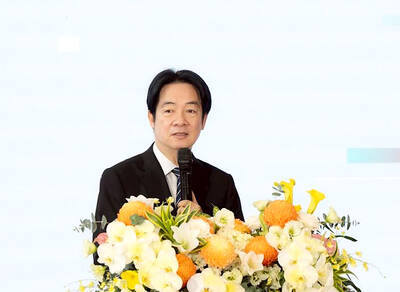President William Lai (賴清德) yesterday urged parties across the political divide to democratically resolve conflicts that have plagued domestic politics within Taiwan’s constitutional system.
In his first New Year’s Day address since becoming president on May 20 last year, Lai touched on several issues, including economic and security challenges, but a key emphasis was on the partisan wrangling that has characterized his first seven months in office.
Taiwan has transformed from authoritarianism into today’s democracy and that democracy is the future, Lai said.

Photo: Lo Pei-de, Taipei Times
“No matter what threats and challenges Taiwan faces, democracy is the only path for Taiwan,” he said. “The only choice is to keep moving forward without looking back.”
Although political party competition is part of the democratic system, “domestic political disputes should be resolved under a democratic approach within the country’s constitutional system,” he said.
However, Lai said that the government and the public have the right to oppose moves by the legislature.
The Constitution says that the Executive Yuan has the right to reject a law passed by the legislature by asking the lawmaking body to reconsider it, or, once the law takes effect, by taking it to the Constitutional Court for adjudication, he said.
People also have the right of “election, recall, initiative and referendum,” enabling them to exercise greater democratic power and show that the people are the source of political legitimacy, he said.
Lai’s comments came as his ruling Democratic Progressive Party (DPP) battles the Chinese Nationalist Party (KMT) and the Taiwan People’s Party (TPP) in the legislature, which together have a majority of seats.
TPP lawmakers have sided with the KMT on legislation that the DPP has opposed, including three bills passed last month that the Cabinet has said it would ask the legislature to reconsider.
The bills, which triggered scuffles in the legislature, cover new measures that tighten recall petition requirements, curb the Constitutional Court’s ability to rule on cases and change central government revenue allocations.
Premier Cho Jung-tai (卓榮泰) said that the Cabinet would take action to counter them, as the three packages are “difficult to implement.”
Later, during a news conference following his New Year’s address, Lai was asked by reporters whether he would invite opposition party leaders for a “reconciliation coffee.”
He said he plans to invite Legislative Speaker Han Kuo-yu (韓國瑜) of the KMT to the Presidential Office for a meeting before Han departs on a trip to attend US president-elect Donald Trump’s inauguration.
In his address at the Presidential Office, Lai said that his government would continue to boost Taiwan’s economic resilience and its integration into global supply chains.
Taiwan would use its strengths in semiconductors and artificial intelligence to deepen the resilience of the “democratic” supply chain, he said.
Through international cooperation, Taiwan would emphasize collaboration in several fields, ranging from drones, low Earth orbit satellites and robots, for the defense, safety and security, biotech, pharmaceutical and green sectors, he said.
Lai called for unity among Taiwanese, regardless of their political differences, so that governments at all levels can enact policies that are beneficial and help Taiwan “continue to walk down the right path.”

MISINFORMATION: The generated content tends to adopt China’s official stance, such as ‘Taiwan is currently governed by the Chinese central government,’ the NSB said Five China-developed artificial intelligence (AI) language models exhibit cybersecurity risks and content biases, an inspection conducted by the National Security Bureau (NSB) showed. The five AI tools are: DeepSeek, Doubao (豆包), Yiyan (文心一言), Tongyi (通義千問) and Yuanbao (騰訊元寶), the bureau said, advising people to remain vigilant to protect personal data privacy and corporate business secrets. The NSB said it, in accordance with the National Intelligence Services Act (國家情報工作法), has reviewed international cybersecurity reports and intelligence, and coordinated with the Ministry of Justice Investigation Bureau and the National Police Agency’s Criminal Investigation Bureau to conduct an inspection of China-made AI language

BOOST IN CONFIDENCE: The sale sends a clear message of support for Taiwan and dispels rumors that US President Donald Trump ‘sold out’ the nation, an expert said The US government on Thursday announced a possible sale to Taiwan of fighter jet parts, which was estimated to cost about US$330 million, in a move that an expert said “sends a clear message of support for Taiwan” amid fears that Washington might be wavering in its attitude toward Taipei. It was the first announcement of an arms sale to Taiwan since US President Donald Trump returned to the White House earlier this year. The proposed package includes non-standard components, spare and repair parts, consumables and accessories, as well repair and return support for the F-16, C-130 and Indigenous Defense Fighter aircraft,

CHECKING BOUNDARIES: China wants to disrupt solidarity among democracies and test their red lines, but it is instead pushing nations to become more united, an expert said The US Department of State on Friday expressed deep concern over a Chinese public security agency’s investigation into Legislator Puma Shen (沈伯洋) for “secession.” “China’s actions threaten free speech and erode norms that have underpinned the cross-strait ‘status quo’ for decades,” a US Department of State spokesperson said. The Chongqing Municipal Public Security Bureau late last month listed Shen as “wanted” and launched an investigation into alleged “secession-related” criminal activities, including his founding of the Kuma Academy, a civil defense organization that prepares people for an invasion by China. The spokesperson said that the US was “deeply concerned” about the bureau investigating Shen

‘TROUBLEMAKER’: Most countries believe that it is China — rather than Taiwan — that is undermining regional peace and stability with its coercive tactics, the president said China should restrain itself and refrain from being a troublemaker that sabotages peace and stability in the Indo-Pacific region, President William Lai (賴清德) said yesterday. Lai made the remarks after China Coast Guard vessels sailed into disputed waters off the Senkaku Islands — known as the Diaoyutai Islands (釣魚台) in Taiwan — following a remark Japanese Prime Minister Sanae Takaichi made regarding Taiwan. Takaichi during a parliamentary session on Nov. 7 said that a “Taiwan contingency” involving a Chinese naval blockade could qualify as a “survival-threatening situation” for Japan, and trigger Tokyo’s deployment of its military for defense. Asked about the escalating tensions